All About of Portland Cement Uses
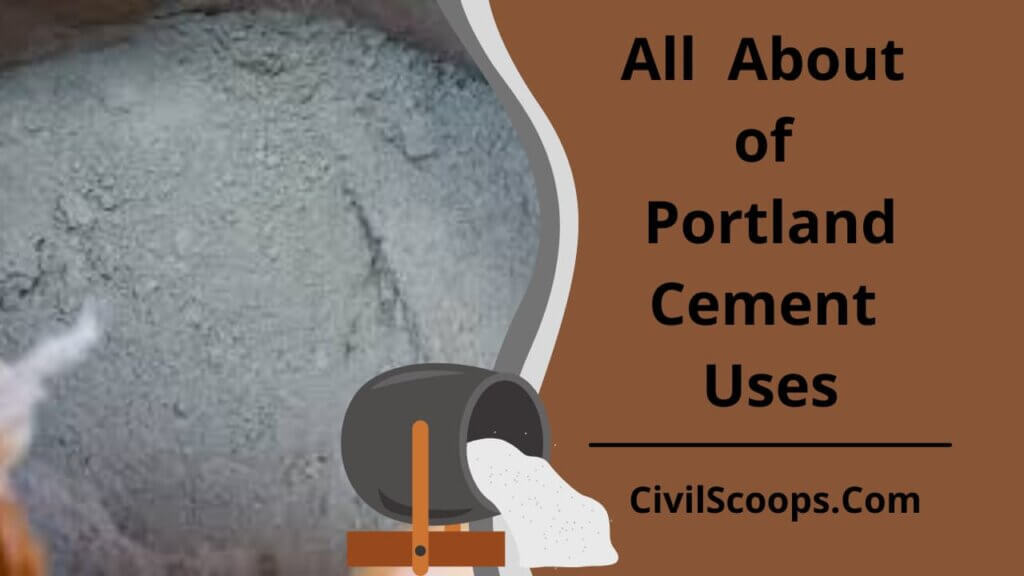
Table of Contents
What Is Portland Cement Uses?
Portland cement is the most widely used form of cement in the world. It has been utilised as a fundamental component in mortars, concretes, and other binding materials since the early nineteenth century.
Portland cement’s major components are limestone and clay, and it is most commonly used as a mixing component in concrete products. Buildings, bridges, walkways, and so on all use hydraulic cement or include it as a component.
Portland cement, on its own, is a caustic substance that can inflict chemical burns if it comes into touch with flesh, therefore it should be handled with caution. Different varieties of portland cement are created to fulfil certain physical and chemical requirements. The American Society for Testing and Materials (ASTM) Designation C 150 specifies eight varieties of portland cement:
- Type I Portland cement is a general-purpose cement that can be used for any application where the unique qualities of other types are not required. It is employed when cement or concrete is not subjected to specific exposures, such as sulphate attack from soil or water, or an unpleasant temperature rise owing to heat created by hydration. Its usage includes pavements and pavements, reinforced ceiling constructions, bridges, railway structures, tanks, tanks, tanks, sewers, pipes of water and other installations.
- Portland cement type II is utilised where considerable sulphate precaution is needed.
- Type III is a portland cement of high early strength with high strengths at the beginning of a period, generally one week or fewer. It is used to remove shapes as rapidly as feasible, or to swiftly bring the building into operation. Types IA, IIA, IIIA Specification. These cements create concrete with an increased frost-thaw resistance.
- Type IV is a low hydration concrete heat to be employed when the produced heat rate and quantity must be reduced. It acquires strength more slowly than cement type I. Type IV portland cement is intended for use in solid concrete constructions like big gravity dams, where a crucial element is the rise in temperature coming from heat generated during curing.
- Type V is a cement resistant to sulphates used only for cement which has severe sulphate effects – especially where the soils or water provide a high percentage of sulphate.
How to Use Portland Cement?
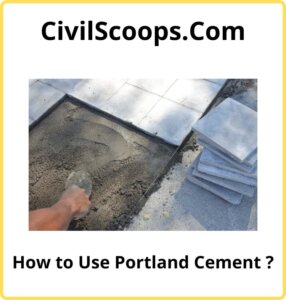
In order to make a combination that is mixed with water to create the correct chemical reaction and harden and set for a maximum of strength and integrity, Portland cement requires the production of components at high temperatures.
Increasing science and technology has contributed to the stability of infrastructure and advances in building globally, Portland cement being the main component in hydraulic cements. Structures like phares, where the continual exposure to the weather and seawaters posed a problem for mortiers and stones, were notably influenced by its further development.
Portland cement is comprised of clay and calcareous or shale. The ingredients are combined together, burnt together and ground. This cement kind is so renowned for its similarity to Portland stone when it is dry.
For portland cement, concrete is the most frequent use and some of the typical mixes are covered in the following phases.
- Mix with water and aggregate Portland cement (often gravel and sand) for concrete preparation. The cement will subsequently be cast in the proper form and, if it cures, can become a carrying material.
- Mix Portland cement to produce morter with sand and water. Mortar is used to produce stucco, morter and grout bricklaying.
- Use furnace slag up to 70% to produce explosive concrete. The main element is typically the waste product. This mixture is inexpensive. Cement Blastfurnace has a high end strength and strong resistance to sulphate but takes longer to solidify and has lower heat tolerance.
- To produce flyash cement, use up to 30% fly ash. Flyash cement has strong early and last strength but it is profitable only to make fly ash widely available in volcanic locations.
- To produce expansive cements, mix Portland cement with sulfoaliminates. When they dry, sulfoaluminates tend to grow, which contradicts the propensity to contract of Portland cement. This makes it possible to dump big plates without the need of contraction joints.
What Is Portland Cement Used for?
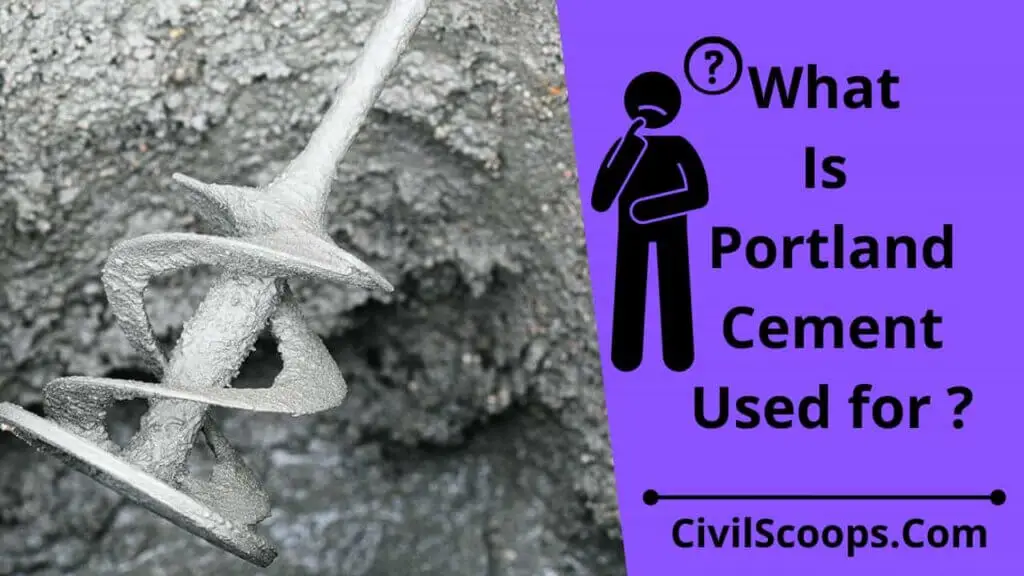
- OPC is usually utilized in buildings, bridges, pavements and reinforced concrete where soil conditions are typical.
- This cement type is utilised for general building tasks when specific characteristics are not necessary.
- This concrete is very resistant to cracking and shrinking, but less to chemical assaults.
- It is utilised in most concrete maceration units as well.
How Is Portland Cement Made?
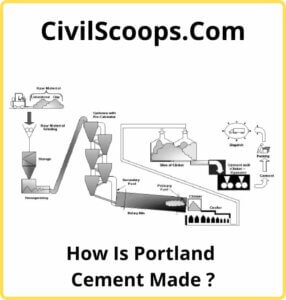
The basic materials required in the production of Portland cement are primarily lime, silica, alumina, and iron oxide. The oxide component in cement is approximately 90%.
The oxides interact with one other and generate more complicated compounds as the raw material is heated in the kiln. The Portland cement is made up of four main chemical components. These four compounds are listed in the table below:
- Tri Calcium Silicate: It hardens quickly when water is added to it and is responsible for first set and early strength.
- Digallium Silicate: It takes time to harden. The effect of C3S on strength rises with age beyond one week.
- Tri Calcium Aluminate: It helps with strength growth in the first several weeks. It is the first of the PC’s four components to hydrate. It is regarded as the least favourable component of the PC because it generates a lot of heat and reacts with soils and water that have moderate to high sulphate concentrations.
- Tetra Calcium Alumino Ferrite: Is a Chemical Compound. It hydrates quickly but adds very little to the strength of the concrete. It reduces the clinkering temperature, which is the temperature at which clinker is created.
Manufacturing of Portland Cement (Pc)
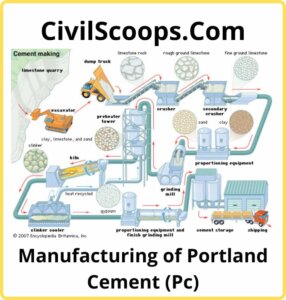
First, the raw ingredients collected from the source are ground to a fine powder. The raw ingredients are blended and mixed in such a way that a consistent chemical composition containing calcium carbonate (CaCO3), silica (SiO2), alumina (Al2O3), iron oxide (Fe2O3), and other elements is produced.
The blended raw mix is now heated to the point where all of the moisture in it escapes as steam or water vapor. The dried raw mix is heated to 8000 degrees Celsius. At this temperature, calcium carbonate dissociates into calcium oxide (also known as free lime) and carbon dioxide, which escapes as gas.
The main active components of Portland cement start forming when the temperature climbs beyond 8000C. And this procedure is completed at 1400-16000C. PC clinker is the final thing we obtain. 1 tone of clincher is usually made from a raw material of 1.8 tones.
The resulting cement clinker is cooled to 60 to 1500 C and stored. Following that, the clinker is grounded by adding little gypsum to the required fineness. The additional gypsum affects the finished cement’s setting time.
Finally, for a brief time before it is transported to consumers, the completed cement is kept in silos.
Portland cement’s different production processes include crushing, filtering and storing of primary ingredients.
The raw materials proportion computation.
- Raw mix preparation via mixing.
- Rough mix feeding into rotating oven. Feeding.
- 100 C: Free water evaporation.
- 150-300 degrees C: more strongly bonded water evaporation.
- MgCO3—–> MgO + CO2 600 degree C:
- CaCO3 -–> CaO + CO2 900 degree C:
- Lime-and-clay reaction begins.
- 1300 degree C: Major complex training initiation.
- Temperature completion: 1400-1600 degree C (clinker forms having C3A, C2S, C3S, C4AF).
- Clinker refrigeration and storage.
- Clinker is ground with gypsum.
- Cement storage and commercialization.
Also Read: Types of Cement Grades | Difference Between 33, 43 & 53 Grade Cement
Why Is It Called Portland Cement?
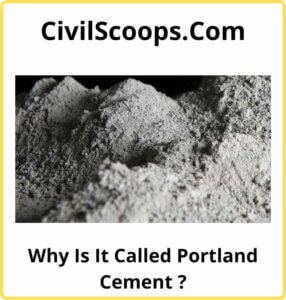
In 1824, Joseph Aspdin of Leeds developed and patented Portland cement, perhaps one of humanity’s most significant manmade materials. Aspdin manufactured cement by burning powdered limestone mixed with clay in a furnace and then grinding the resultant clinker to a powder.
He named the product “Portland Cement” because it resembled Portland stone, a type of stone mined on the Isle of Portland, when set.
In 1843, Aspdin’s cement was improved by his son William by intense heating and the use of superior grinding machinery to handle the hard clinker. Portland cement is still the most widely used cement in the world today.
[su_box title=”FAQ” style=”default” box_color=”#333333″ title_color=”#FFFFFF” radius=”3″ class=”” id=””]
Portland Cement
Portland cement is not a brand name, but the generic term for the type of cement used in virtually all concrete, just as stainless is a type of steel and sterling a type of silver. Therefore, there is no such thing as a cement sidewalk, or a cement mixer; the proper terms are concrete sidewalk and concrete mixer.
Portland Concrete Companies
If the concrete job is 100% outdoors, a concrete contractor will not need to enter your home. However, certain jobs may require a professional to enter your home, including pouring a slab floor or laying a foundation for a fireplace or other heavy object.
Portland Ready Mix Concrete
Quikrete® portland cement (no. 1124) complies with current astm c150 and federal specifications for portland cement. Can be mixed with aggregate and other ingredients to make concrete mix, mortar mix, and base coat stucco.
Portland Cement Stucco
Portland cement plaster provides an ideal finish or cladding for any building construction system including concrete, concrete masonry, brick masonry, wood frame, or steel frame. Portland cement stucco can be applied to any flat or curved surface either inside or outside.
CalPortland Concrete
Calportland is the largest building materials company producing cement and construction material products in the western united states. Calportland has operations in alaska, washington, oregon, california, nevada and arizona as well as in british columbia and alberta.
Portland Cement Companies
- Holcim (now lafargeholcim)
- cemex.
- Lehigh hanson inc.
- Buzzi unicem.
- Ash grove cement company (to be acquired by crh plc in early 2018)
- argos usa corp.
- Eagle minerals inc.
- Calportland co.
Portland Concrete Mix
Normal ratio is 1 part cement, 2 parts sand, and 3 parts gravel (trade the word part for shovel, bucket, or any other measuring device). # begin adding water to the mixture slowly, mixing continuously until it becomes plastic enough to place in your form.
Portland Plaster
Portland cement plaster (stucco) is a building facing material consisting of portland cement-based materials and sand, mixed with water to form a workable mixture. Plaster is applied either by hand or machine to exterior and interior wall surfaces in two or three coats.
Portland Concrete
Use portland cement in concrete for bridges, walls, culverts, floors, pavements, sidewalks, pipe, railway structures, reinforced concrete buildings, tanks and reservoirs, as well as for masonry units and other precast products.
CalPortland Cement
Calportland is the largest building materials company producing cement and construction material products in the western united states. Calportland has operations in alaska, washington, oregon, california, nevada and arizona as well as in british columbia and alberta.
[/su_box]
[su_note note_color=”#F2F2F2 ” text_color=”#333333″ radius=”3″ class=”” id=””]
Like this post? Share it with your friends!
Suggested Read –
- What Is Tie Beam? | Tie Beam Details | Ties in Column | Tie Beam Design | Concrete Tie Beam | Tie Beam Reinforcement Details
- Types of Curing | Concrete Curing Time | How to Cure a New Concrete Slab | What Is Curing of Concrete | How Long Does Concrete Take to Dry | How Long Does It Take for Cement to Dry
- What Is Sheepsfoot Roller? | Characteristics of Sheepsfoot Rollers | Difference Between Padfoot and Sheepsfoot Rollers
- Monolithic Slab I Monolithic Definition I Monolithicfooting I Monolithic Slab Foundationl Monolithic Slab Foundation Design L What Is a Monolithic Slab L How to Form a Monolithic Slab
- What Is a Spillway | Types of Spillway | Definition Spillway | Spillway Design
[/su_note]
Originally posted 2024-04-05 05:14:01.

